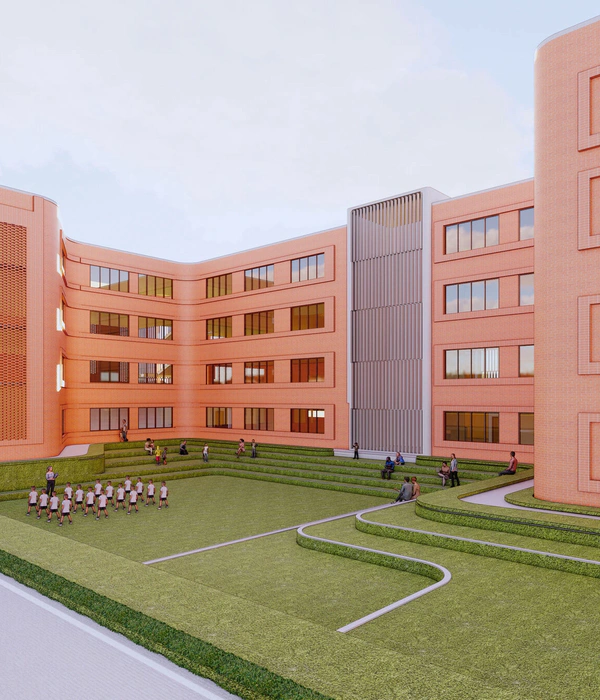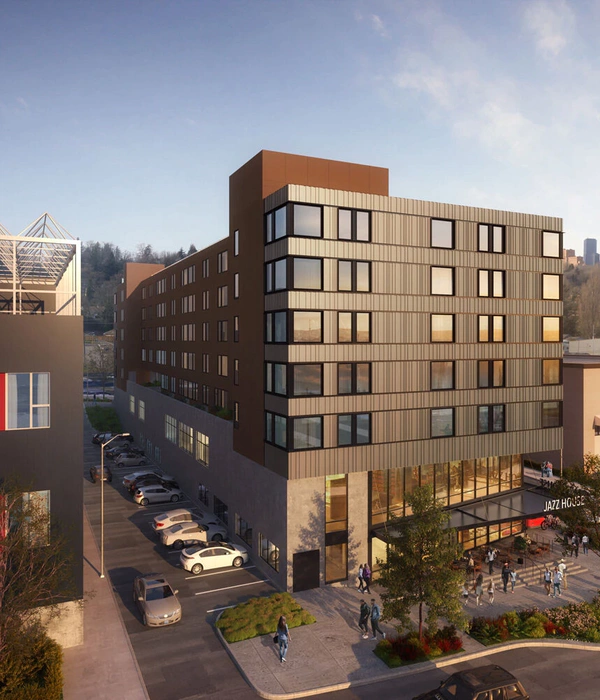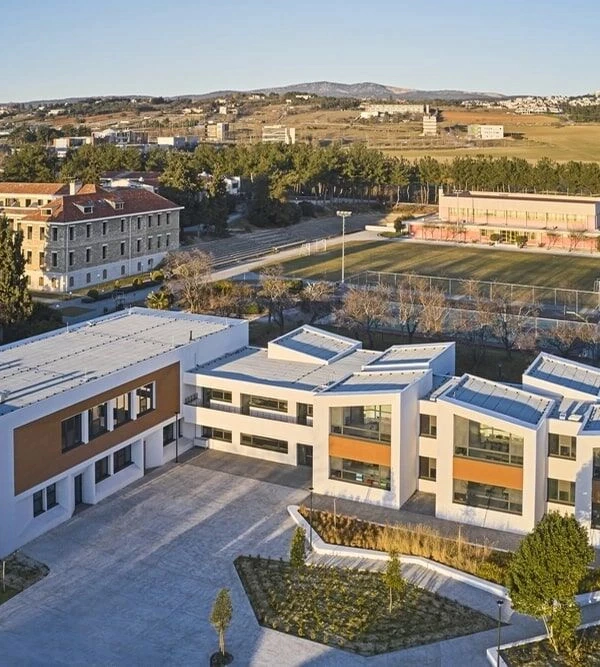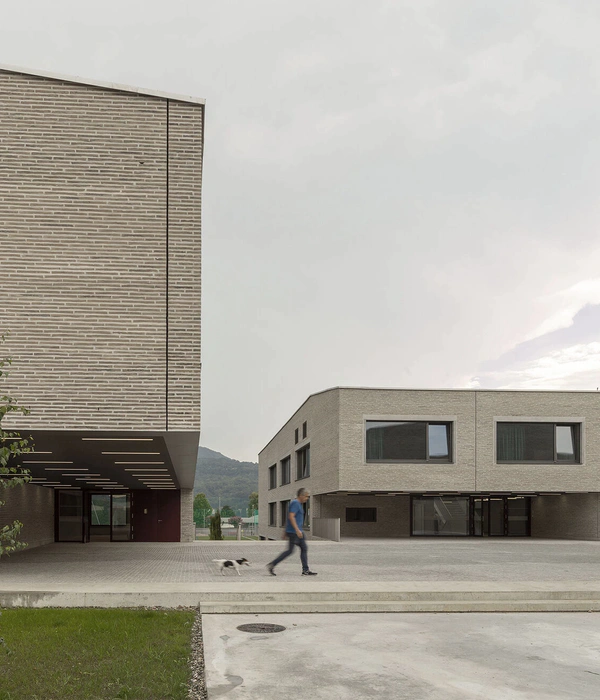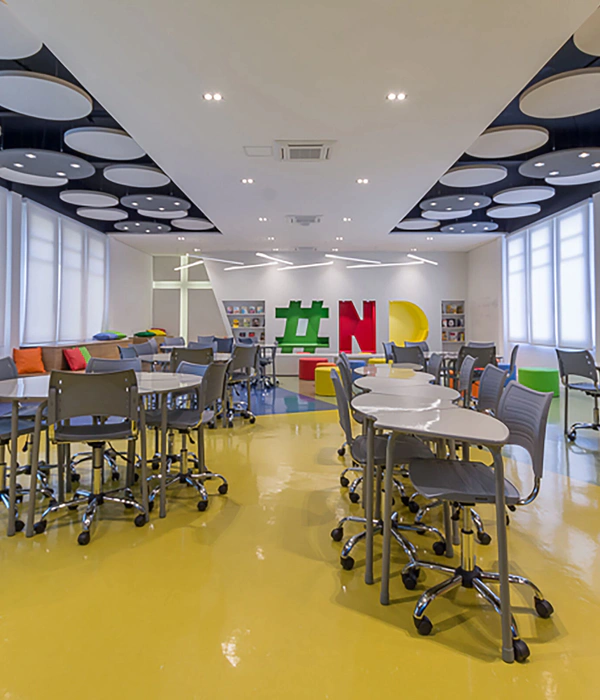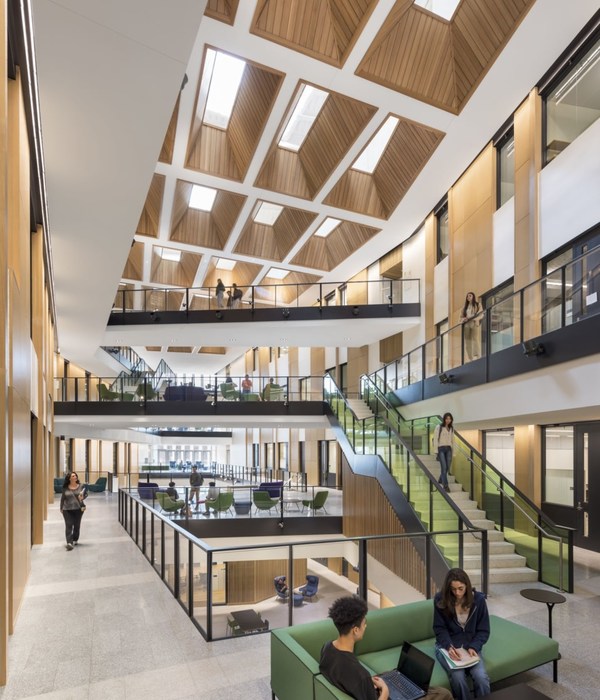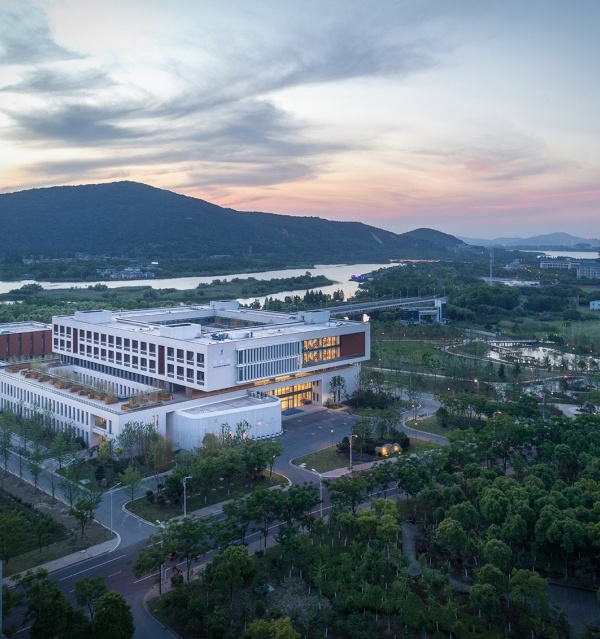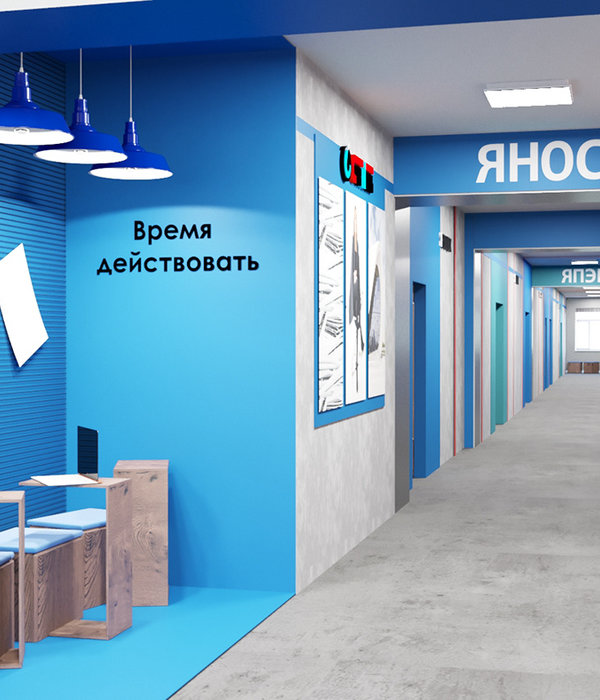伊娃和卡洛斯,他们与两只比利时马利诺犬(比舒和邦巴)、猫头鹰哈里斯、数个家庭单位的雨燕和红隼以及二十只麻雀共同生活在这座位于马德里以西30公里处的建筑中。附近是一片田野,既有的乡村环境在近几十年间受到了城市开发和依赖农药的密集型农业的影响,而这所训练学校正在通过实验来寻找恢复生态系统的方法。
Eva, Carlos, two Belgian Malinois – Bicho and Bomba –, Harris the owl, five swift families, six kestrel families and twenty sparrows, are all companion species. They live and learn together in this building, thirty kilometres west of Madrid. Sitting in amongst fields, in a rural environment transformed over recent decades by urban development and intensive pesticide-reliant agriculture, Educan School is trialling ways to recover the conditions of the ecosystem.
▼建筑外观,Exterior view © Javier de Paz García
▼建筑北立面,North facade © Javier de Paz García
建筑的设计旨在为多物种服务。两个主要的教室用于训练犬类的敏捷性,或进行Schutzhund运动;鸟类在顶部的立面上筑巢,拥有理想的视野和朝向;以啮齿动物为食物的鸟类与农作物和其他当地植物维持了平衡的关系。另外一些小型鸟类和蝙蝠居住在南立面的“字母”上,它们都以昆虫为食(包括可能携带某些犬类疾病的蚊子),并成为了生长在附近田野的花卉授粉周期的一部分。麻雀们会不定期地出现于这个自我调节的生态系统,并在集装箱边缘的圆洞中筑巢。
▼轴测图,Axonometric View © Eeestudio + Lys Villalba
Its architecture is a multi-species design. While the two main classrooms are busy with dog–human pairs practising agility or dog sports like Schutzhund, birds nest on the upper floor’s nest-facade, boasting ideal views and orientation. Small birds of prey feed on rodents, maintaining a balance with crops and other local flora. Small birds and bats – who also inhabit the lettering on the south facade – feed on insects, including mosquitoes that can carry certain canine diseases, and are part of the pollination cycles of flowers and plants in the surrounding fields. Sparrows made an impromptu appearance in this self-regulating ecosystem, nesting in the circular holes of the container edges.
▼夏日的南立面,South facade in summer © José Hevia
▼立面细节,Detailed view © José Hevia
▼可供不同动物使用的小喷泉,Multi-specie fountain © José Hevia
▼南立面入口细节,South facade opening detail © José Hevia
▼入口卷帘,The roller blinds © José Hevia
设计的中心思路在于它并非只为人类而设计。通常方便穿鞋行走的地板在这里变成了适合犬类脚掌和关节的表面:训练教室使用了符合犬类训练规范的、以PTE为基底的可拆卸人工草皮;理论教室使用了半抛光的、以河卵石制成的裸料混凝土。平均视线高度从1.5m以上调整至0.5米。室内门窗的位置被提高到1米以上,以避免扰乱狗的注意力。百叶窗遮挡住南立面,同时在下方留出足够的空间,方便狗的出入。屋顶上的大水槽可以收集雨水,供狗和鸟使用。声学设计方面也以犬吠而非人声为参照:室内表面覆盖着吸声的金字塔型泡沫隔层,可以最大程度地减少回声、噪音和残响。
▼室内单元细节,Construction Details © Eeestudio + Lys Villalba
Non-humans are at the centre of the design. The floors, usually designed for people and their shoes, are adapted to the pads and joints of canine paws: the training classrooms use removable rolls of PTE-based synthetic turf, approved for canine training, while theory classrooms are finished in semi-polished, exposed aggregate concrete made of river pebbles. The average eye height drops from over a metre and a half, to just half a metre. Interior openings are raised to heights of more than one meter to avoid doggy distractions; louvred window shutters shade the south facade, leaving enough space below for dog traffic to the outside, where rainwater from the roof is harvested in large troughs for dogs and birds. Spoken word turns bark, and the interior surfaces are clad with sound-absorbing pyramid foam insulation, minimising echo, noises and reverberation.
▼从室内望向入口,Interior view towards the opening © José Hevia
▼主训练空间,Main training space © José Hevia
▼训练室台阶道具,Step in the main space © José Hevia
▼从主空间望向小教室,View to the rear classroom from the main space © José Hevia
▼隔墙和窗洞细节,Partition and opening details © José Hevia
▼主训练空间和后方小教室,Main training space and rear space © Javier de Paz García
▼位于后方的小教室,Rear space © José Hevia
▼训练台细节,Step detail © José Hevia
该建筑使用了多种材料,并结合了不同的建造技术、手艺和生产系统。航运集装箱的再利用兼顾了材料的生态型和废料的减少;现浇混凝土保证了适应能力和热质量;新桁架的边角料被用于制作光滑而起伏的混凝土模具。从工业金属板的标准化和优化,到数控切割接头的精度;从基础构件(如40’ HC集装箱)的工业标准化,到提供定制接头、定制组件和特殊单元(如长凳腿、灯具或用于划分空间的大型滑动门)的手工铁制品;从自动化的空调系统,到可手动调节的生物气候控制单元(如穿孔百叶窗或卷帘);从厚重的地基和混凝土墙壁,再到轻盈的干式组装元素。Educan学校作为一个实验性的项目,向我们证明了:即使是通常我们所认为的学科中的“次要部分”,也同样能为探索与建筑创新提供广阔的舞台。
▼材料生态系统,Material Ecosystem © Eeestudio + Lys Villalba
The building uses a diverse range of materials, combining different building techniques, trades and production systems: from material ecology and waste reduction with the reuse of shipping containers, to the adaptability and thermal mass provided by in-situ concrete and its smooth and undulating formwork using sheets recovered from the off-cuts for the new trusses; from the standardisation and optimisation of industrial metal sheet panels to the precision of laminated timber CNC-cut joints; from the industrial standardisation of basic ingredients like 40′ HC containers to the hand-crafted ironwork offering customised joints, bespoke assemblies and unique elements such as bench legs, lamps or large sliding doors helping open and close the different spaces; from automated air conditioning systems to manual bioclimatic control elements like the perforated shutters or roller blinds; from the material weight of the foundations and concrete walls to the lightness of the rest of the dry-assembled elements.
Educan is also an experiment that demonstrates that agricultural architectures, usually considered lesser within the discipline itself, can also be places of exploration and architectural innovation.
▼主训练室桁架和墙面,Trusses and walls in the main space © Javier de Paz García
▼室内和材料细节,Interior and material details © José Hevia
▼墙面和灯具细节,Wall and lamp details © Javier de Paz García
▼外观细节,Facade details © José Hevia
▼小型鸟类居住在南立面的“字母”上,Small birds inhabit the lettering on the south facade © José Hevia
▼冬天的西立面,West facade in winter © Javier de Paz García
▼夜景,Night view © Javier de Paz García
▼场地平面图,Site view © Eeestudio + Lys Villalba
▼平面图,Floor plan © Eeestudio + Lys Villalba
▼南北剖面图,North-South section © Eeestudio + Lys Villalba
▼东西剖面图,West-East section © Eeestudio + Lys Villalba
Architects: Enrique Espinosa (Eeestudio) y Lys Villalba. Poject: Educan. Escuela para perros, humanos y otras especies. Location: Brunete, Madrid (Spain) Date: Design: 2017-2018. Construction: March 2019-November 2020 Built area: 300m2 Client: Adiestramiento Educan Construction company: Servicios Integrales Alji / Construcciones Metálicas Miguel Torrejón Team: Javier Reñones Marín (building engineer), Mecanismo (structural engineers), Alberto Espinosa (bulding services engineer), Jorge López Hidalgo (technical consultant), Maria Paola Marciano e Irene Domínguez (collaborators). Photographs: Javier de Paz García and José Hevia.
Awards EU Mies Award 2022. Nominee. MATCOAM Award 2021. First Prize. Matcoam Innovation Prize. FAD Award 2021. Selected work. Architecture. COAM Award. Honorable Mention. Architecture. MAPEI Award 2021. Sustainable Architecture. Shortlisted.
▼项目更多图片
{{item.text_origin}}

